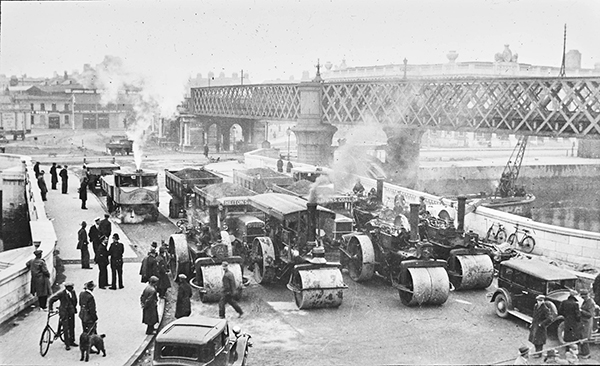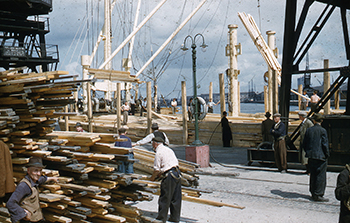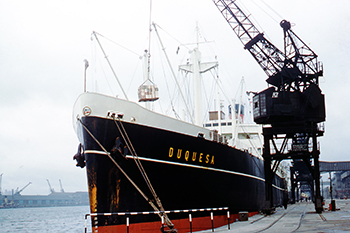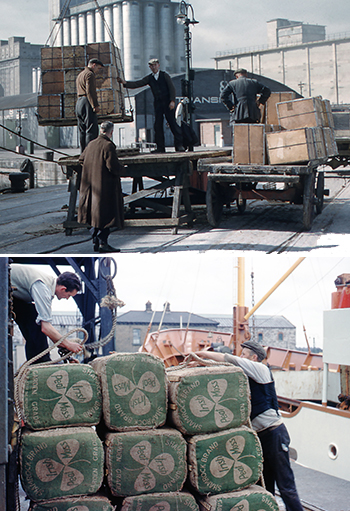Port views
Published in Features, Issue 6 (November/December 2020), Volume 28The Dublin Port Company photographic archive.
By Aidan Crawley
Recent years have witnessed an explosion in public interest in old or historical photographs, as evidenced by the number of social media sites dedicated to the past and by cultural institutions such as the National Library and the National Museum hosting photographic exhibitions dedicated to Ireland’s past to meet the demands of an increasingly nostalgic public. ‘Nostalgia’ in the seventeenth century meant chronic homesickness, whereas now it means a longing for the past rather than for a place, a longing met by collections of photographs in both the private and public spheres. Even the National Gallery has departed from the traditional medium of painting and begun to embrace the medium of photography.
Shannon scheme photographs
Public companies have also recognised the importance of maintaining their photographic archives, most notably the ESB, whose collection includes the celebrated photography of the construction of the hydroelectric dam at Ardnacrusha. Siemens, who constructed the power station in the 1920s, employed their own photographers to document the project, at all times displaying the technical and artistic facets of the Neue Sachlichkeit or ‘New Objectivity’, an artistic movement in post-First World War Germany which railed against the ideals of expressionism, celebrating instead functionality and objectivity. In the medium of photography this meant breaking away from pictorialism by framing and composing imagery in a more realistic and objective manner. Sorcha O’Brien examines the ESB archive in detail in her book Powering the nation: images of the Shannon Scheme and electricity in Ireland (2017).

Above: Steam traction engines and heavily laden coal trucks conduct a weight test on Butt Bridge prior to its opening in time for the 1932 Eucharistic Congress. (Dublin Port Company Archive)
Another Irish company that is maintaining its heritage is the Dublin Port Company, whose archive dates back 300 years. A sizeable portion of this collection is made up of photographs dating from the late nineteenth century up to the late twentieth century, including both black-and-white glass plate negatives and colour transparency photographs (or colour slides). Many of the glass plate negatives in the Dublin Port archive date from the early twentieth century and were taken for the purposes of illustrating reports commissioned by Dublin Port during major construction projects.
Dublin’s bridges

Above: A cargo of planks being unloaded, c. 1960. Note the large number of dockers involved in the operation. Within a few years containerisation would greatly reduce the size of the workforce. (Dublin Port Company Archive)
Good examples include the construction of Butt Bridge between 1930 and 1932, overseen by Joseph Mallagh, chief engineer of the Dublin Port and Docks Board. The original Butt Bridge, constructed in 1884, was situated at Custom House Quay. It was a Victorian cast-iron central swivel bridge designed by chief engineer Bindon Blood Stoney (pictured on p. 27, HI 28.3, May/June 2020). It preceded the much-maligned Loopline Bridge, built in 1891 to connect the southern and northern rail lines in the city, which blocked views of Gandon’s neoclassical Custom House. Stoney’s bridge was designed to swivel 90 degrees, allowing ships to berth on both Burgh and Eden Quays, and was the first of its kind in the city. The bridge was single-carriage with a footpath on either side but had not been used for its intended purpose since the late nineteenth century. It was also not wide enough to accommodate the increased volume of traffic. Public frustration with the bridge was reflected in a satirical article printed in the February 1930 edition of Dublin Opinion:
‘There is a tradition (invented by our tradition inventing department) that a poor lad who came up to Dublin from the Midlands to seek his fortune, after trying and trying, that he was apparently no use at anything, and in despair threw himself into the river. On coming up for the second time, he saw the structure of Butt Bridge above him. Thereupon he immediately exclaimed with a slight stutter, due the action of the water, “W-W-Well, if t-that’s a bridge, I’m an architect!”. Recovering his courage, he swam out to embrace the classic profession, and is now in the first rank amongst its Irish exponents.’
Bridge-building along the River Liffey faced bureaucratic difficulties owing to the complexity of governance of the river area in Dublin City. The original 1787 act that constituted the Ballast Office gave it responsibility for the city’s quays. The subsequent 1811 act included all bridges that had been constructed up to that time and any future bridge construction. All bridges and quays that were made redundant by the construction of Carlisle Bridge (where O’Connell Bridge is now located) in 1794 were levied with a tax against Dublin Corporation. Therefore bridges to the east of Carlisle Bridge were administered by the Ballast Board and those to the west by Dublin Corporation.
Animosity between the Port and Docks Board and Dublin Corporation over bridges ran deep and often ended up in court. Even naming rights became a contentious issue, as both parties believed that they had the right to name bridges. The new Butt Bridge was the first to span the Liffey in the twentieth century and it was the first to be built using reinforced concrete.
Containerisation

Above: The cargo vessel Duquesa docked in Alexandra Basin in May 1960. (Dublin Port Company Archive)
Within the archive there is a small collection of colour slide photographs dating from the 1950s and ’60s. They were taken on Kodak Kodachrome colour reversal film, first introduced by Kodak in 1935, which was regarded by professional photographers as the best format for shooting colour images. Its vivid colour reproduction was highly regarded. The photographs are mostly of shipping and port operations, depicting the work practices of dockers at the time just prior to modernisation of the shipping industry through the introduction of containerisation. The shipping container, invented by American shipping entrepreneur Malcolm McLean in 1956, would have a detrimental impact both on both the lives of dockers and on the docks where they worked. In less than two decades great ports like London and much of Dublin’s docks would become industrial wastelands, as modern containerised shipping required new ports and less labour to load and unload ships.

Above: Chests of tea (top) coming in; bales of peat moss (below) going out. The photographs are an important visual reference to the types of cargos being imported and exported through Dublin Port, providing an insight into both production and consumption in the wider Irish economy. (Dublin Port Company Archive)
Dublin Port’s footprint has decreased in size from its peak in the mid-twentieth century to the area in which it operates today. In the 1960s the docks ran down both sides of the River Liffey from the Custom House to Alexandra Basin, employing thousands of dockers on a casual basis. Today the port inhabits far less space beyond the East Link bridge, employing only a handful of dockers compared to its peak but handling far more freight. The river quays have been redeveloped into a post-industrial cityscape; once dominated by warehousing, it is now dominated by offices, apartments and retail spaces. This change in cityscape has led to the gentrification of the traditional dockland area, affecting the working-class communities who lived and worked there.
The historical value of the photographs documenting the port cannot be overstated, as the images capture an era when modernisation was quickly changing the world of shipping. The photographs are representative of ports and dockers globally, as work practices and traditions were similar in every port. When the photographs are examined, they reveal much about the social and economic life of Ireland during the period.
These photographs are unique in a number of ways. Firstly, they are the only colour photographs of the era in the Dublin Port collection, thus making them an excellent example of colour photography in Ireland at a time when black and white was still the norm. Secondly, being in colour makes them an invaluable historical source, as they are a realistic representation of Irish economic, social and labour history. Thirdly, they portray a way of life that would rapidly disappear not only in Dublin but also in ports the world over after the introduction of the shipping container. Lastly, the photographs are an important visual reference to the types of cargos being imported and exported through Dublin Port, providing an insight into both production and consumption in the wider Irish economy.
Duquesa
A forensic examination of the photographs reveals rich visual reference to the economy of Ireland in the period. For example, two of the photographs in the collection are of a large cargo vessel named the Duquesa (Duchess), which is pictured in Alexandra Basin. It was built in Tyneside in 1949 for the Houlder-Furness Argentine Lines Ltd, based in London and operated on a shipping route between Buenos Aires and London. All ships in the company were recognised by their black funnels, which had a red stripe emblazoned with a white Maltese Cross. When delivered, the ship boasted the largest refrigerated capacity in the world. It served with the company until it was sold to the Royal Mail Lines Ltd in 1968, and decommissioned and broken up in La Spezia, Italy, a year later. The photographs of the ship are undated, but an examination of Dublin Port shipping movements published daily in the Irish Times reveals that the photographs were taken some time between 10 and 12 May 1960. The Duquesa is reported to have arrived from Buenos Aires via London on 10 May 1960 with a cargo of apples and general cargo, and departed light (empty) for Buenos Aires two days later on 12 May, suggesting that no exports of Irish goods were shipped to Argentina. While in port, the ship was unloaded by dockers employed by one of the prominent Dublin stevedoring companies, George Bell & Co. These photographs are therefore an invaluable insight into the economic and social history of Ireland in the period.
Many of the photographs depict dockers loading or unloading ships at quaysides. Dock working by its nature was manual and physically demanding. Stephen Hill, writing in The dockers: class and tradition in London (London, 1976), argues that referring to dockers as manual labourers implies that they are unskilled. Much of the work, however, was very skilled, requiring many years of experience for full proficiency. Variation in cargo required different handling procedures and, as there was no formal training, skills were learned from experienced dockers. Apart from their historical value in visualising the work methods employed by dockers, the photographs also highlight the labour-intensive nature and inefficiency of shipping and handling break-bulk cargo.
Dublin Port Company 2040 Masterplan
A key part of the Dublin Port Company 2040 Masterplan is to integrate the port into the social fabric of the city and its people. Up until the early 1980s, it was a common sight to see ships berthed along the Liffey quays, making the port an integral part of the cityscape. As the footprint of the port has become smaller and more streamlined, however, it has become detached from the city. The Dublin Port Company feels that ‘… a port which serves the city, but which remains detached and isolated from the society that it serves, will be regarded as little more than an intrusive and unappealing blight on the city’. Therefore the company is actively attempting to integrate the port back into the city through cultural and heritage programmes. To address the need to preserve its history, Dublin Port has appointed a full-time heritage officer, Lar Joye, to oversee the company’s archive of photographs, engineering drawings, maps, charts and company records dating back 300 years. He contends that ‘what is in the archive is the bedrock of what we are doing: that forms the research and academic basis, and the physical projects we develop in the coming years will be very much dependent on that’. The photographs in the collection will form a key part of that heritage, acting as an accurate visual record of the port’s history and an important cultural asset, not only to Dublin port and city but to broader port culture.
Photographer Aidan Crawley was awarded an MA in Collections and Curating from the School of Art History and Cultural Policy, UCD.
FURTHER READING
D. Dickson, Dublin: the making of a capital city (London, 2014).
M. Levinson, The box: how the shipping container made the world smaller and the world economy bigger (Princeton, 2006).
S. O’Brien, Powering the nation: images of the Shannon Scheme and electricity in Ireland (Newbridge, 2017).
A. O’Carroll & D. Bennett, The Dublin docker: working lives of Dublin’s deep-sea port (Dublin, 2017).
















